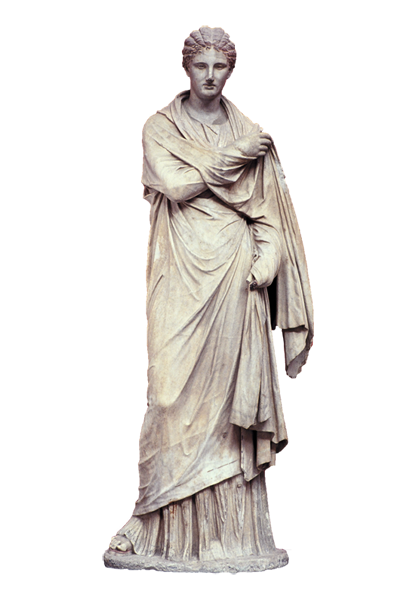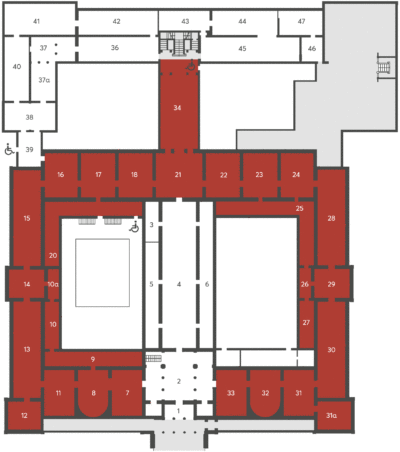Exhibit of the month
Sumptuously embroidered fabrics …
ἣ δὲ μέγαν ἱστὸν ὕφαινε,
δίπλακα πορφυρέην, πολέας δ᾽ ἐνέπασσεν ἀέθλους
Τρώων θ᾽ ἱπποδάμων καὶ Ἀχαιῶν χαλκοχιτώνων
she (Helen) was weaving a great purple web of double fold, and thereon was broidering many battles of the horse-taming Trojans and the brazen-coated Achaeans.
The Iliad Book III, ll. 125-127[1].
Funerary statue of a female figure
National Archaeological Museum
Sculpture Collection, inv. no 1827
Provenance: found on Delos in 1894
Dimensions: Height: 1.75 m
Date: copy of the 2nd c. BC of an original work dating to 320-300 BC
Display location: Sculpture Collection, Room 21.
The female figure is depicted standing, dressed in a full-length chiton and a long himation covering almost the entire body and arms, whereas one of its edges is fastened before her chest. Her hair is combed in a melon coiffure. The sculpture is a copy of a famous original work created most likely by Praxiteles or a sculptor of his circle in around 300 BC, rendered in the so-called Small Herculaneum Woman type, that has been named after the best-preserved work found at Herculaneum in Italy together with the statue of a more mature figure, known as the Large Herculaneum Woman. The two types were extensively used from the 3rd c. BC to the 3rd c. AD in rendering statues of the elite class or members of the imperial house, whereas the original works possibly depicted goddesses (probably Demeter and Persephone).
Traces of colour have been preserved on a fairly large surface of the statue. More specifically on the hair, the eyes, the lips but mostly on the garments and the visible sandal. By studying the report of the French excavator Louis Couve, regarding the preserved colour during the recovery of the sculpture, and also by applying specialized photographic techniques (Ultraviolet Fluorescence – UVF, Ultraviolet Reflectance – UVR and Visible-Induced Infrared Luminescence – VIL) and microscopic observation, the Sculpture Conservation Laboratory of the NAM made possible the identification of Egyptian blue among the pigments, its spatial distribution, as well as highlighting the preserved decorative patterns and motifs. The proposed design and colour reconstructions suggest a motif of successive triangles along the edge of the himation and running spiral that adorns the vertical edge of the chiton.
The accounts of the ancient writers, the epigraphic sources, but also the few surviving fragments of ancient textiles often bear testimony to their decoration. The more common decorative techniques were dying, embroidery, tapestry and decoration with sewen patterns (peripoikila, patterned textiles). The ancient sculptures, such as the statue in question, offer a vivid picture of the decorative motifs of fabrics, which are often rendered in colour or by engraving for the addition of pigments. The patterns are usually scattered all over the garment, whereas special attention is paid on the edges (borders), the neckline, the hemline and the sleeve hems.
A characteristic example is the purple chiton of Kore Phrasikleia, adorned with incised and painted motifs —a meander pattern that runs vertically the central band, the ends and the seamline of the sleeves, tongue-shaped leaves along the hemline, spirals and triangles on the belt, rosettes, meander crosses and stars dispersed across the entire surface of the attire. Relief motifs are rarer, such as the relief rosettes on the sleeves of Kore inv. no 15464, whereas there exist also garments with figurative representations in relief, arranged in parallel bands, imitating the so-called historemena (illuminated) textiles[2].
Precious fabrics scattered with linear, geometric or vegetal patterns and edges adorned with running spirals, meanders and successive triangles are frequently encountered in vase painting, in which the artists can render details using added gold and white paint. Narrative scenes arranged in zones decorate similarly the extravagant attire of deities or mythological figures, ritual garments and bed coverings.
[1] Homer. The Iliad with an English Translation by A.T. Murray, Ph.D. in two volumes. Cambridge, MA., Harvard University Press; London, William Heinemann, Ltd. 1924
[2] The historemena (illuminated) fabrics are garments or other lavish textiles (bed coverings, curtains etc) adorned with figurative, narrative scenes of mythological features or animals in miniature friezes. Original ancient textiles, manufactured with tapestry or embroidery, are extremely hard to find, due to their perishable material. However, there are several representations of these textiles in vase painting, metalwork, minor arts and sculpture.
Ι. Panagakos – K. Tsakri – Chr. Tsouli
Bibliography:
L. Couve, Fouilles à Delos. Juillet-Septembre 1894, BCH 19, 1895, 482 ff., pl. 7.
Β. Bourgeois – P. Jockey, The polychromy of Hellenistic Marble Sculpture in Delos, in: V. Brinkmann – O. Primavesi – M. Hollein (eds), Circumlitio. The Polychromy of Antique and Medieval Sculpture, München 2010, 226 ff., 230 ff., 235.
C. Blume, Polychromie hellenistischer Skulptur, Petersberg 2015, 195-99, cat. no 25, and 61-66 (generally on the painted decoration of garments).
Suggested general bibliography on the painted decoration of Archaic statues
Δ. Μπίκα, Μελέτη της πολυχρωμίας της αρχαϊκής γλυπτικής, doctoral thesis, ΕΚΠΑ, Αθήνα 2015.
B. Schmaltz, Το άγαλμα της Φρασίκλειας – περί της πολυχρωμίας της ελληνικής γλυπτικής, in Μ. Λαγογιάννη (ed.) Οδύσσειες, έκθεση στο ΕΑΜ, Αθήνα 2016, 151-56.
Suggested general bibliography on the decoration of textiles
Ε.J.W. Barber, Prehistoric Textiles, 1991, 358 ff. (for the textiles of historical times).
Ε. Μανακίδου, Ιστορημένα υφάσματα. Μια κατηγορία μικρογραφικών παραστάσεων πάνω σε αττικά αγγεία, in: J.H. Oakley – W.D.E. Coulson – O. Palagia (eds) Athenian Potters and Painters Ι, Oxford 1997, 297-308.



